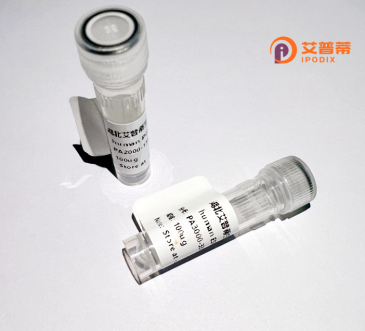
| 纯度 | >90%SDS-PAGE. |
| 种属 | Human |
| 靶点 | POFUT2 |
| Uniprot No | Q9Y2G5 |
| 内毒素 | < 0.01EU/μg |
| 表达宿主 | E.coli |
| 表达区间 | 1-429 aa |
| 活性数据 | MATLSFVFLLLGAVSWPPASASGQEFWPGQSAADILSGAASRRRYLLYDVNPPEGFNLRRDVYIRIASLLKTLLKTEEWVLVLPPWGRLYHWQSPDIHQVRIPWSEFFDLPSLNKNIPVIEYEQFIAESGGPFIDQVYVLQSYAEGWKEGTWEEKVDERPCIDQLLYSQDKHEYYRGWFWGYEETRGLNVSCLSVQGSASIVAPLLLRNTSARSVMLDRAENLLHDHYGGKEYWDTRRSMVFARHLREVGDEFRSRHLNSTDDADRIPFQEDWMKMKVKLGSALGGPYLGVHLRRKDFIWGHRQDVPSLEGAVRKIRSLMKTHRLDKVFVATDAVRKEYEELKKLLPEMVRFEPTWEELELYKDGGVAIIDQWICAHARFFIGTSVSTFSFRIHEEREILGLDPKTTYNRFCGDQEKACEQPTHWKITY |
| 分子量 | 76.4 kDa |
| 蛋白标签 | GST-tag at N-terminal |
| 缓冲液 | PBS, pH7.4, containing 0.01% SKL, 1mM DTT, 5% Trehalose and Proclin300. |
| 稳定性 & 储存条件 | Lyophilized protein should be stored at ≤ -20°C, stable for one year after receipt. Reconstituted protein solution can be stored at 2-8°C for 2-7 days. Aliquots of reconstituted samples are stable at ≤ -20°C for 3 months. |
| 复溶 | Always centrifuge tubes before opening.Do not mix by vortex or pipetting. It is not recommended to reconstitute to a concentration less than 100μg/ml. Dissolve the lyophilized protein in distilled water. Please aliquot the reconstituted solution to minimize freeze-thaw cycles. |
以下是关于重组人POFUT2蛋白的3条参考文献示例:
1. **文献名称**:*Protein O-fucosyltransferase 2 (POFUT2) regulates thrombospondin type 1 repeat protein stability and signaling*
**作者**:Wang Y. et al.
**摘要**:研究了POFUT2通过O-岩藻糖基化修饰调控含有血小板反应蛋白重复结构域(TSR)的蛋白稳定性,揭示其在细胞外基质信号传导及胚胎发育中的关键作用。
2. **文献名称**:*Structural basis of O-glycosylation by the inverting enzyme POFUT2*
**作者**:Luo Y., Haltiwanger R.S.
**摘要**:通过X射线晶体学解析了POFUT2的三维结构,阐明其催化TSR结构域O-岩藻糖基化的分子机制及底物特异性识别原理。
3. **文献名称**:*Defective POFUT2 disrupts Notch signaling and causes limb patterning defects in mice*
**作者**:Li Z. et al.
**摘要**:利用基因敲除小鼠模型,证明POFUT2缺失导致Notch受体异常糖基化,进而引发肢体发育缺陷,强调其在Notch信号通路中的调控作用。
(注:以上为示例性内容,实际文献需根据具体研究补充。)
POFUT2 (Protein O-fucosyltransferase 2) is a key enzyme in eukaryotic organisms that catalyzes the transfer of fucose to specific serine or threonine residues on target proteins via O-glycosidic linkages. This post-translational modification, termed O-fucosylation, occurs predominantly on thrombospondin type-1 repeats (TSRs) found in extracellular proteins like ADAMTS proteases, Notch ligands, and certain cytokines. The addition of O-linked fucose is critical for proper protein folding, secretion, and functional interactions in cellular signaling pathways, particularly those regulating development and tissue homeostasis.
POFUT2 is conserved across metazoans and operates in the endoplasmic reticulum. Its enzymatic activity is dependent on the consensus sequence C1-X-X-S/T-C2-X-X-X-G in TSR motifs. Dysregulation of POFUT2 has been linked to human pathologies, including connective tissue disorders, cancer metastasis, and Dowling-Degos disease—a rare genetic condition associated with hyperpigmentation and skin abnormalities.
Recombinant human POFUT2 (rhPOFUT2) is typically produced using mammalian expression systems (e.g., HEK293 or CHO cells) to ensure proper glycosylation and folding. It serves as a vital tool for studying O-fucosylation mechanisms, developing glycosylation-modulating therapeutics, or engineering glycoproteins with enhanced stability. Research applications also include disease modeling and screening for inhibitors to target POFUT2-related disorders. Advances in structural biology have elucidated its catalytic domain and substrate-binding sites, enabling rational design of enzyme variants for biotechnological use.
×